Bharat Petroleum Bundle
How Does Bharat Petroleum Navigate India's Dynamic Energy Sector?
The Indian oil and gas industry is undergoing a significant transformation, driven by shifting consumer demands and a global push towards sustainable energy. Bharat Petroleum SWOT Analysis reveals the company's strategic positioning in this evolving environment. As a leading player, BPCL's ability to adapt and innovate is crucial for maintaining its competitive edge. Understanding BPCL's competitive landscape is key to grasping its future prospects.
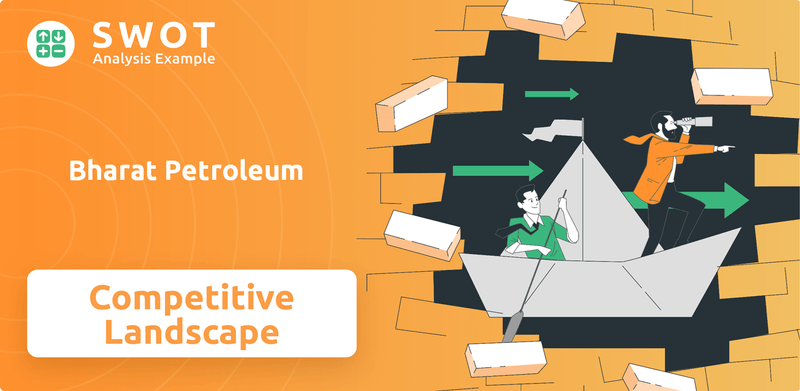
This analysis delves into the Competitive landscape of Bharat Petroleum (BPCL), examining its position within the oil and gas industry. We will explore BPCL market share analysis, identify its industry competitors, and assess BPCL's competitive advantages. Furthermore, this report provides insights into BPCL's financial performance compared to competitors, offering a comprehensive market analysis to understand who are BPCL's main rivals and the challenges it faces.
Where Does Bharat Petroleum’ Stand in the Current Market?
BPCL, or Bharat Petroleum, holds a significant position within the Indian oil and gas industry. As of FY2024, the company secured a market share of approximately 25.37% in the domestic oil marketing business, including private players, making it the second-largest OMC in India. This strong market presence is a key aspect of its competitive strategy within the Marketing Strategy of Bharat Petroleum.
BPCL's core operations involve refining crude oil and marketing a diverse range of petroleum products. The company is India's third-largest oil refining company, with a total refining capacity of 35.3 million metric tonnes per annum (MMTPA), representing around 14% of India's total refining capacity. Its strategic locations of refineries in Mumbai, Kochi, and Bina provide logistical advantages, supporting its extensive retail network and customer base.
The company's primary product lines include petrol, diesel, aviation turbine fuel (ATF), and liquefied petroleum gas (LPG), along with lubricants, greases, and petrochemical products. BPCL also deals in natural gas and is expanding into renewable energy sources like biofuels and solar energy. This diversification and expansion strategy is crucial for maintaining its competitive edge in the evolving energy market.
BPCL is the second-largest OMC in India with a market share of approximately 25.37% in the domestic oil marketing business. It is also the third-largest oil refining company in India.
BPCL has a total refining capacity of 35.3 MMTPA, which accounts for about 14% of India's total refining capacity. The refineries are strategically located in Mumbai, Kochi, and Bina.
BPCL's product range includes petrol, diesel, ATF, LPG, lubricants, and petrochemical products. It is also expanding into natural gas and renewable energy.
BPCL has an extensive retail network with over 21,142 retail outlets and 6,245 LPG distributors. The company is focused on digital transformation to enhance customer experience.
For the fiscal year ended March 31, 2025, BPCL reported a consolidated net profit of ₹13,336.55 crore with a total income of ₹5,03,202.20 crore. The company's total assets grew to ₹1,87,994.54 crore as of March 31, 2025, and maintained a debt-equity ratio of 0.29.
- BPCL's GRM for FY 2024-25 dropped to $6.82 per barrel.
- Domestic market sales increased by 1.82% year-over-year in Q1 2025.
- Gas sales volume grew by 13.9%.
- Commissioned 1,805 new retail outlets and expanded its EV charging network to 6,563 stations in FY 2024-25.
Bharat Petroleum SWOT Analysis
- Complete SWOT Breakdown
- Fully Customizable
- Editable in Excel & Word
- Professional Formatting
- Investor-Ready Format
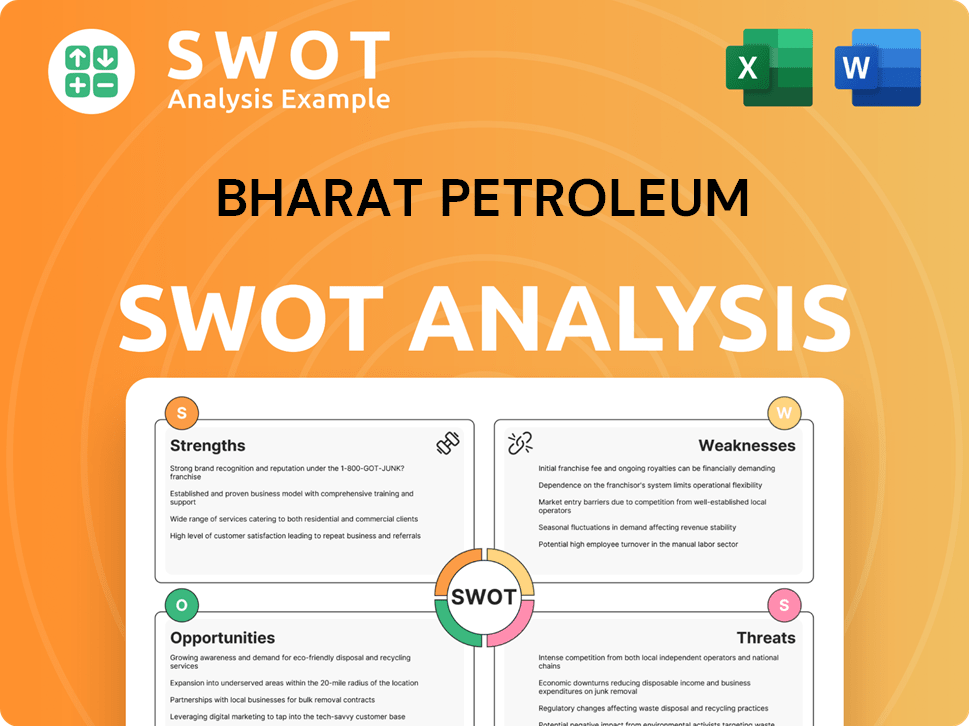
Who Are the Main Competitors Challenging Bharat Petroleum?
The Indian oil and gas industry is fiercely competitive, and the competitive landscape for Bharat Petroleum (BPCL) is shaped by a mix of public and private sector players. Understanding the key competitors is crucial for assessing BPCL's market position and strategic challenges. This analysis provides insights into the major rivals and the competitive dynamics within the industry.
The competitive environment involves constant price wars, innovation in product offerings, and the battle for market share through brand recognition and distribution network strength. The rise of renewable energy and electric vehicle charging further complicates the landscape. For a deeper understanding of how BPCL generates revenue, consider reading about the Revenue Streams & Business Model of Bharat Petroleum.
BPCL operates in a highly competitive Indian oil and gas market, facing both direct and indirect competition. Its primary competitors include other public sector oil marketing companies (OMCs) and a major private conglomerate. These competitors challenge BPCL through various means, including price competition, innovation in product offerings, and brand recognition.
IOCL is the largest OMC in India, posing a significant challenge to BPCL. IOCL's extensive refining capacity, vast distribution network, and diverse product portfolio give it a competitive edge. In 2022, IOCL's new logistics strategy led to a 12% decrease in delivery times.
HPCL is another major public sector OMC that competes directly with BPCL across refining, marketing, and distribution segments. These two entities often vie for similar market segments and customer bases.
RIL, a major private player, is a diversified conglomerate with significant interests in energy, petrochemicals, and retail. RIL's integrated operations and aggressive market strategies make it a strong competitor. RIL's refining capacity and retail network pose a substantial threat.
MRPL is a notable competitor in the refining and petrochemicals sector. Its operations and market presence contribute to the overall competitive dynamics of the industry.
Chennai Petroleum Corporation Ltd is another key player in the refining sector, adding to the competitive pressure faced by BPCL and other OMCs.
New and emerging players in renewable energy and electric vehicle charging are disrupting the traditional landscape. BPCL is expanding its EV charging network, indicating the growing competition in alternative fuels. Mergers and alliances, such as BPCL's joint ventures in green hydrogen and compressed biogas, also reshape competitive dynamics.
The competitive landscape is shaped by several factors, including pricing, innovation, and distribution. BPCL and its competitors constantly adjust their strategies to maintain or increase market share. The industry is also affected by global oil prices and government policies.
- Price Competition: Auto fuels are subject to constant price adjustments.
- Product and Service Innovation: Loyalty programs and digital initiatives.
- Brand Recognition and Distribution: Strengthening networks to reach customers.
- Renewable Energy: Expansion into EV charging and alternative fuels.
- Mergers and Alliances: Joint ventures in green hydrogen and biogas.
Bharat Petroleum PESTLE Analysis
- Covers All 6 PESTLE Categories
- No Research Needed – Save Hours of Work
- Built by Experts, Trusted by Consultants
- Instant Download, Ready to Use
- 100% Editable, Fully Customizable
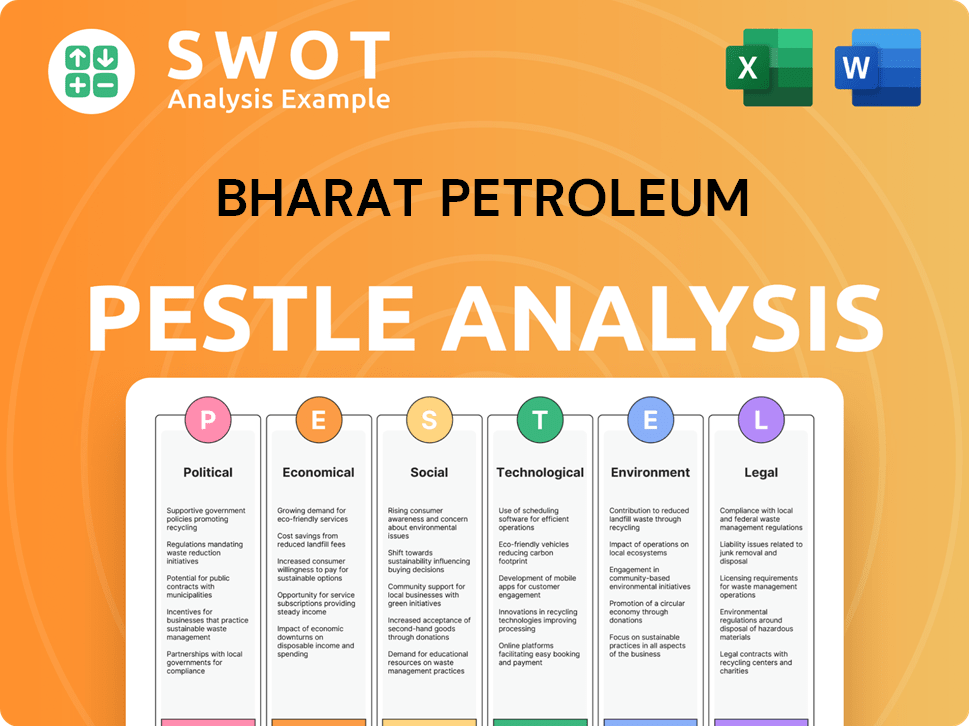
What Gives Bharat Petroleum a Competitive Edge Over Its Rivals?
Understanding the competitive landscape of Bharat Petroleum (BPCL) requires a deep dive into its core strengths and strategic positioning within the Indian oil and gas industry. BPCL, a prominent player, leverages several key advantages to maintain its market position. These advantages include its strong government backing, extensive infrastructure, operational efficiencies, and strategic partnerships. Analyzing these elements provides a comprehensive view of BPCL's ability to compete effectively.
BPCL's competitive edge is further enhanced by its focus on innovation and sustainable practices. The company's investments in research and development, along with its commitment to low-carbon technologies, position it well for future growth. Examining these aspects, along with its financial performance compared to competitors, offers insights into its long-term viability in the dynamic energy market. For further details on the ownership structure, you can refer to Owners & Shareholders of Bharat Petroleum.
As of December 31, 2024, the Government of India held a 52.98% stake in BPCL, providing a significant financial advantage. This ownership structure supports BPCL's strategic importance in the domestic energy sector and contributes to its strong brand recognition. The company's widespread presence and strategic alliances also contribute to its sustained competitive position.
BPCL's majority government ownership provides substantial financial flexibility. This backing supports its strategic initiatives and enhances its ability to navigate market challenges. The government's stake offers a competitive advantage in terms of access to capital and strategic decision-making.
BPCL operates three major refineries and a vast retail network. These assets ensure a broad market reach and strong brand recall, especially with its 'Bharatgas' LPG brand. Its widespread network supports its ability to compete effectively in the oil and gas industry.
BPCL consistently maintains high-capacity utilization levels in its refineries. The company's focus on innovation and its substantial intellectual property portfolio, with over 450 patents as of 2023, drive product development and align with sustainability goals.
BPCL has formed strategic alliances with over a dozen global energy players. Recent joint ventures in 2025, such as with Sembcorp Green Hydrogen India Private Limited and GPS Renewables Private Limited, demonstrate its commitment to sustainable growth and expanding into emerging energy segments.
BPCL's competitive advantages are multifaceted, encompassing government support, extensive infrastructure, operational excellence, and strategic partnerships. These factors collectively contribute to its strong market position and resilience within the Indian energy sector. These advantages are crucial for BPCL's sustained competitive position in the evolving energy market.
- Government Ownership: Provides financial stability and strategic backing.
- Extensive Infrastructure: Includes refineries and a vast retail network.
- Operational Efficiency: High capacity utilization and continuous improvement.
- Strategic Partnerships: Diversifies crude oil sources and expands into new energy segments.
Bharat Petroleum Business Model Canvas
- Complete 9-Block Business Model Canvas
- Effortlessly Communicate Your Business Strategy
- Investor-Ready BMC Format
- 100% Editable and Customizable
- Clear and Structured Layout
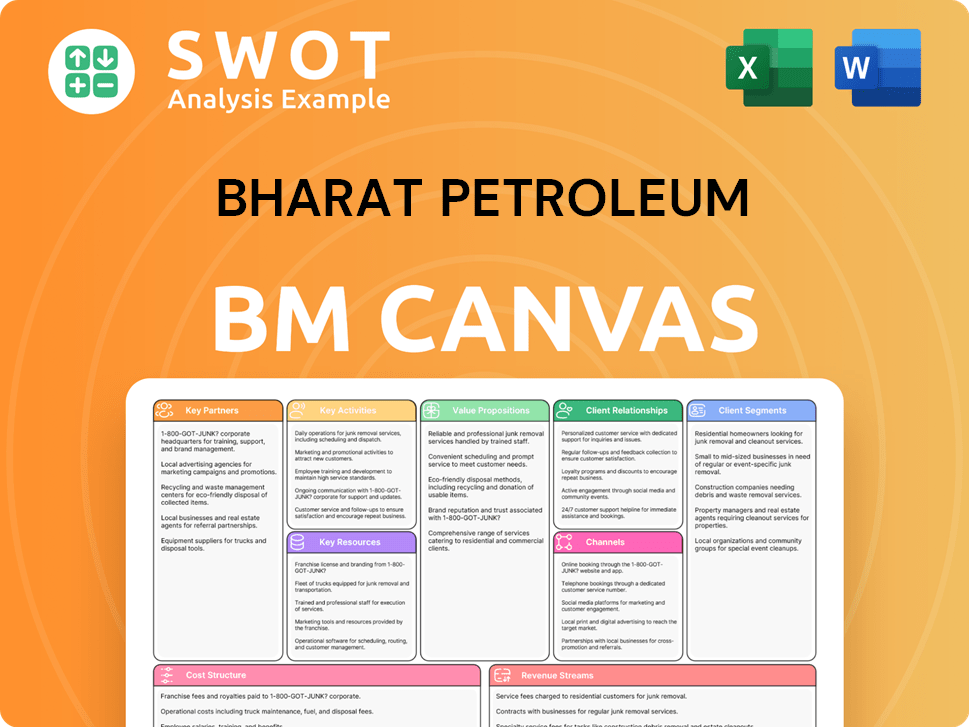
What Industry Trends Are Reshaping Bharat Petroleum’s Competitive Landscape?
The competitive landscape for Bharat Petroleum (BPCL) in the Indian oil and gas industry is dynamic, shaped by energy transition, increasing demand, and regulatory changes. BPCL's strategic initiatives, including investments in renewables and EV infrastructure, are critical for navigating these shifts. Understanding the market dynamics, including the strategies of industry competitors, is vital for assessing BPCL's future growth prospects.
The company faces challenges such as global refining margin volatility and competition, while also benefiting from opportunities in petrochemicals and digital transformation. The company's planned capital expenditure of around ₹1.70 lakh crore over the next five years (FY25-FY29) underscores its commitment to growth and sustainability in a rapidly evolving market. A detailed competitive analysis of Bharat Petroleum in India is essential for investors and stakeholders.
The Indian oil and gas sector is experiencing a significant shift towards decarbonization, with India targeting Net Zero emissions by 2070. This drives BPCL to invest in renewable energy, aiming for 1 GW capacity by 2025 and 10 GW by 2040. Increasing demand for petroleum products and natural gas presents opportunities for BPCL.
BPCL faces challenges from volatile global refining margins and the pricing of sensitive petroleum products. Increased competition from both public and private players, as well as new entrants in the renewable energy space, will require continuous innovation and strategic adaptation. The company must navigate the impact of global oil prices on BPCL's competition.
Opportunities for BPCL include diversification into petrochemicals and gas, digital transformation to enhance customer experience, and sustainability initiatives. The company's planned capital expenditure of around ₹1.70 lakh crore over the next five years (FY25-FY29) demonstrates its strategic focus on growth. BPCL's strategies for sustainable growth are key.
Regulatory changes, such as the Oilfields (Regulation and Development) Amendment Bill, 2024, and the Open Acreage Licensing Policy (OALP X), create opportunities. India's oil demand is projected to rise by 3.39% in 2025. BPCL aims to mitigate import dependence by diversifying crude oil sources.
BPCL's strategic focus includes renewable energy, EV charging infrastructure, and digital transformation. The company is expanding its EV charging network, with 6,563 stations in FY 2024-25. BPCL's expansion plans and competition are influenced by these initiatives.
- Investment in green energy projects.
- Expansion of EV charging network.
- Diversification into petrochemicals and gas.
- Focus on digital transformation.
Bharat Petroleum Porter's Five Forces Analysis
- Covers All 5 Competitive Forces in Detail
- Structured for Consultants, Students, and Founders
- 100% Editable in Microsoft Word & Excel
- Instant Digital Download – Use Immediately
- Compatible with Mac & PC – Fully Unlocked
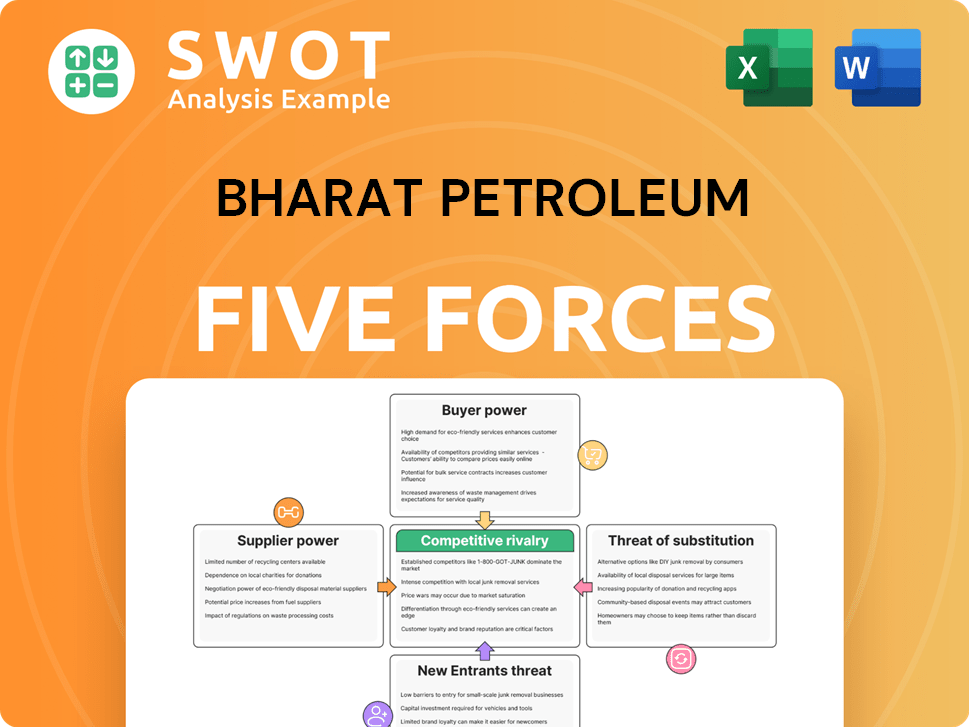
Related Blogs
- What are Mission Vision & Core Values of Bharat Petroleum Company?
- What is Growth Strategy and Future Prospects of Bharat Petroleum Company?
- How Does Bharat Petroleum Company Work?
- What is Sales and Marketing Strategy of Bharat Petroleum Company?
- What is Brief History of Bharat Petroleum Company?
- Who Owns Bharat Petroleum Company?
- What is Customer Demographics and Target Market of Bharat Petroleum Company?
Disclaimer
All information, articles, and product details provided on this website are for general informational and educational purposes only. We do not claim any ownership over, nor do we intend to infringe upon, any trademarks, copyrights, logos, brand names, or other intellectual property mentioned or depicted on this site. Such intellectual property remains the property of its respective owners, and any references here are made solely for identification or informational purposes, without implying any affiliation, endorsement, or partnership.
We make no representations or warranties, express or implied, regarding the accuracy, completeness, or suitability of any content or products presented. Nothing on this website should be construed as legal, tax, investment, financial, medical, or other professional advice. In addition, no part of this site—including articles or product references—constitutes a solicitation, recommendation, endorsement, advertisement, or offer to buy or sell any securities, franchises, or other financial instruments, particularly in jurisdictions where such activity would be unlawful.
All content is of a general nature and may not address the specific circumstances of any individual or entity. It is not a substitute for professional advice or services. Any actions you take based on the information provided here are strictly at your own risk. You accept full responsibility for any decisions or outcomes arising from your use of this website and agree to release us from any liability in connection with your use of, or reliance upon, the content or products found herein.